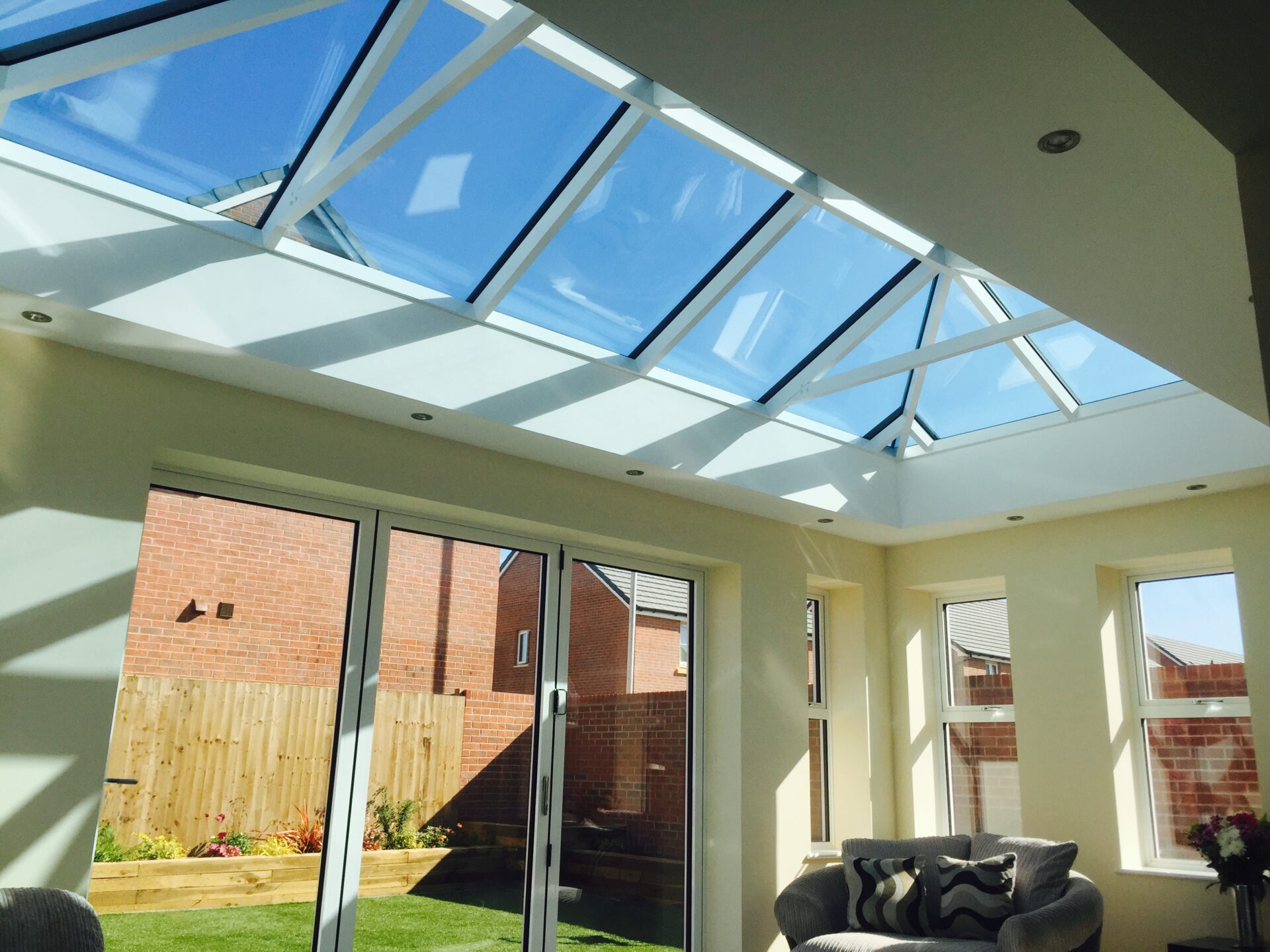Last Updated on 15 November 2024 by Team GFD
When it comes to enhancing the aesthetics of a home and introducing natural light into interior spaces, roof lanterns have become an increasingly popular choice for many homeowners.
However, although popular, one common concern among those contemplating the installation of roof lanterns is whether they contribute to overheating in the room.
In this article, we’ll delve into the factors influencing room temperature in the presence of roof lanterns and discuss various strategies that can help to mitigate these potential heat-related issues.
Looking for some specific info? Jump to:
- How roof lanterns affect room temperature
- How to combat room heating from roof lanterns
- Invest in Energy-efficient Roof Lanterns
- FAQs
How roof lanterns affect room temperature
Roof lanterns play a significant role in influencing room temperature and their impact can be understood through several general factors:
Sunlight exposure
The amount and intensity of natural light that roof lanterns bring into a room can affect its temperature. Direct sunlight can lead to increased warmth, particularly during peak hours and sunny days.
Heat absorption
The materials used in the construction of roof lanterns, especially the glazing, contribute to heat absorption. The choice of materials can influence how much heat is retained and radiated into the interior space.
Ventilation options
Roof lanterns with ventilation options, such as vents or openers to allow for airflow, provide a means to regulate airflow. Proper ventilation helps prevent the accumulation of air, contributing to effective temperature control.
Our Atlas roof lanterns come in a range of different styles to cater for different preferences.
Heat reflection properties
The presence of heat-reflective coating on the glazing can minimise the transfer of heat into a room. Roof lanterns designed with such properties aim to balance natural light benefits with temperature regulation.
Orientation and placement
The orientation and placement of roof lanterns on the roof structure impact their exposure to sunlight. Strategic placement can minimise direct exposure during peak sunlight hours, helping control indoor temperatures.
Seasonal considerations
Room temperature dynamics can vary with seasons. In colder months, the warming effect of sunlight may be beneficial, while in warmer months, measures may be needed to prevent overheating.
You may also want to read our ‘Do Roof Lanterns Make The Room Cold?’ article.
How to combat room heating from roof lanterns
Here are the main ways to combat room heating for roof lanterns:
Invest in roof lanterns with heat reflection
To address the concern of a room becoming too hot due to a roof lantern, consider investing in models designed with heat reflection properties. Advanced technology in glazing and coatings can help to minimise the amount of heat that enters the space.
Heat-reflective roof lanterns allow you to enjoy the benefits of natural light without compromising on comfort.
Choose a roof lantern with ventilation
An extremely effective way to combat rising temperatures is to opt for roof lanterns equipped with ventilation options. Many roof lantern designs now either come with integrated vents, allowing hot air to escape and promoting better airflow, or an option to add openers to allow for ventilation.
We’re pleased to confirm that all of our roof lanterns come with the option to add openers, providing an easy solution to regulate the temperature inside the room.
For information on roof lantern pricing, check out our ‘How Much are Roof Lanterns’ article.
Position the roof lantern out of direct sunlight
Proper placement of the roof lantern can significantly impact its impact on room temperature. If possible, choose to position your lantern in a way that minimises direct exposure to intense sunlight, especially during peak hours.
This strategic placement can help prevent excessive heat buildup inside the room.
Add blinds for sun control
As well as choosing the right roof lantern, choosing shades or blinds for roof lanterns can be another way to control the amount of sunlight entering the room, however this is considered a very specialist solution and most likely one of the most expensive too!
Invest in Energy-efficient Roof Lanterns with GFD Homes
If you’re looking to strike a perfect balance between natural light and energy efficiency, we’d recommend taking a look at our stunning range of Atlas and Korniche roof lanterns. These designs prioritise not only heat reflection but also incorporate features that contribute to overall energy conservation.
This means you’re not only investing in roof lanterns that ensure a comfortable living environment, but ones that also minimise energy consumption too, possibly saving you money on energy costs.
To start your roof lantern search, feel free to browse our website. Alternatively, if you have some questions about roof lanterns and need some help, don’t be afraid to contact us on 01642 309576.
(Live close to the Teesside area? Why not book a visit to our one-of-a-kind showroom, we promise you’ll be blown away!)
FAQs about roof lanterns making the room hot
Do roof lanterns have vents?
Yes, many roof lantern designs include vents that allow hot air to escape, promoting better ventilation and temperature regulation.
At GFD Homes, we appreciate that some customers may not want a roof lantern with ventilation, this is why every roof lantern in our collection comes with an option to add openers for airflow.
Where should a roof lantern be placed to avoid heating the room?
To avoid excessive heating, position the roof lantern in a way that minimises direct exposure to intense sunlight. Make sure to carefully consider the orientation of your home and the path of the sun throughout the day.
Will a roof lantern retain heat?
While roof lanterns can contribute to heat retention, choosing models with heat-reflective coatings and proper ventilation options can help minimise this effect.
Investing in energy-efficient designs, such as the ones we supply, also aids in maintaining a comfortable room temperature.
How do I clean and maintain a roof lantern?
To clean roof lanterns without self-cleaning glass you just need a hose or a bucket of soapy water, along with a non-abrasive sponge. Gently scrub the glass and rinse thoroughly with water. Always avoid using harsh chemicals or abrasive materials that may damage the roof lantern.
For interior glass, a mild glass cleaner and a soft cloth or sponge can be used. Wipe down the glass in a circular motion to remove any smudges or fingerprints.
To avoid having to worry about cleaning, we’d recommend choosing one from our Korniche collection, as each one comes with self-cleaning glass as standard, so you don’t have to worry about external maintenance.
Do roof lanterns affect energy bills?
Energy-efficient roof lanterns can contribute to energy savings by reducing the need for artificial lighting during the day. Additionally, models with heat-reflective coatings can help regulate indoor temperatures, potentially lowering the reliance on heating or cooling systems.
Are roof lanterns suitable for all types of homes?
Roof lanterns can be suitable for various types of homes, including traditional and contemporary designs, however the suitability may depend on factors such as roof structure, room size and personal aesthetic preferences.
We’d recommend consulting with a professional to determine the best fit for your specific home.
Do roof lanterns generate heat?
Lanterns, particularly roof lanterns, do not inherently generate heat on their own. The primary function of a lantern is to allow natural light into a space. However, the impact on room temperature can be influenced by factors such as sunlight exposure, glazing materials and the design of the roof lantern.
Do roof lanterns make the room too hot?
The potential for roof lanterns to make a room too hot depends on various factors. Direct sunlight exposure, especially during peak hours, can lead to increased heat inside the room.
However, advancements in roof lantern designs, such as heat-reflective coatings and ventilation options aim to mitigate heat build-up, providing a comfortable living environment.
What are the disadvantages of roof lanterns?
While roof lanterns offer numerous advantages, including enhanced natural light and a sense of openness, there are some potential disadvantages to consider (it’s important to understand that all these disadvantages can be mitigated, as explained below):
1) Possible heat buildup in the summer – Always opt for a roof lantern that has heat-reflective coatings to minimise heat absorption and maintain a comfortable indoor temperature.
2) Regular maintenance – Choose a roof lantern with self-cleaning glass so you don’t have to worry about constantly reaching your roof lantern for routine cleaning.
3) Installation costs – Although roof lantern installation prices can involve a larger upfront cost compared to other lighting solutions, their impact on improved aesthetics and property value make them a worthwhile investment.
When it comes to finding installers to fit your roof lantern, always remember to check their reviews and guarantees- don’t be afraid to shop around for better fitting prices!
By carefully considering these factors and implementing the appropriate measures mentioned above, you’ll be able to maximise the benefits a roof lantern will offer your home.

